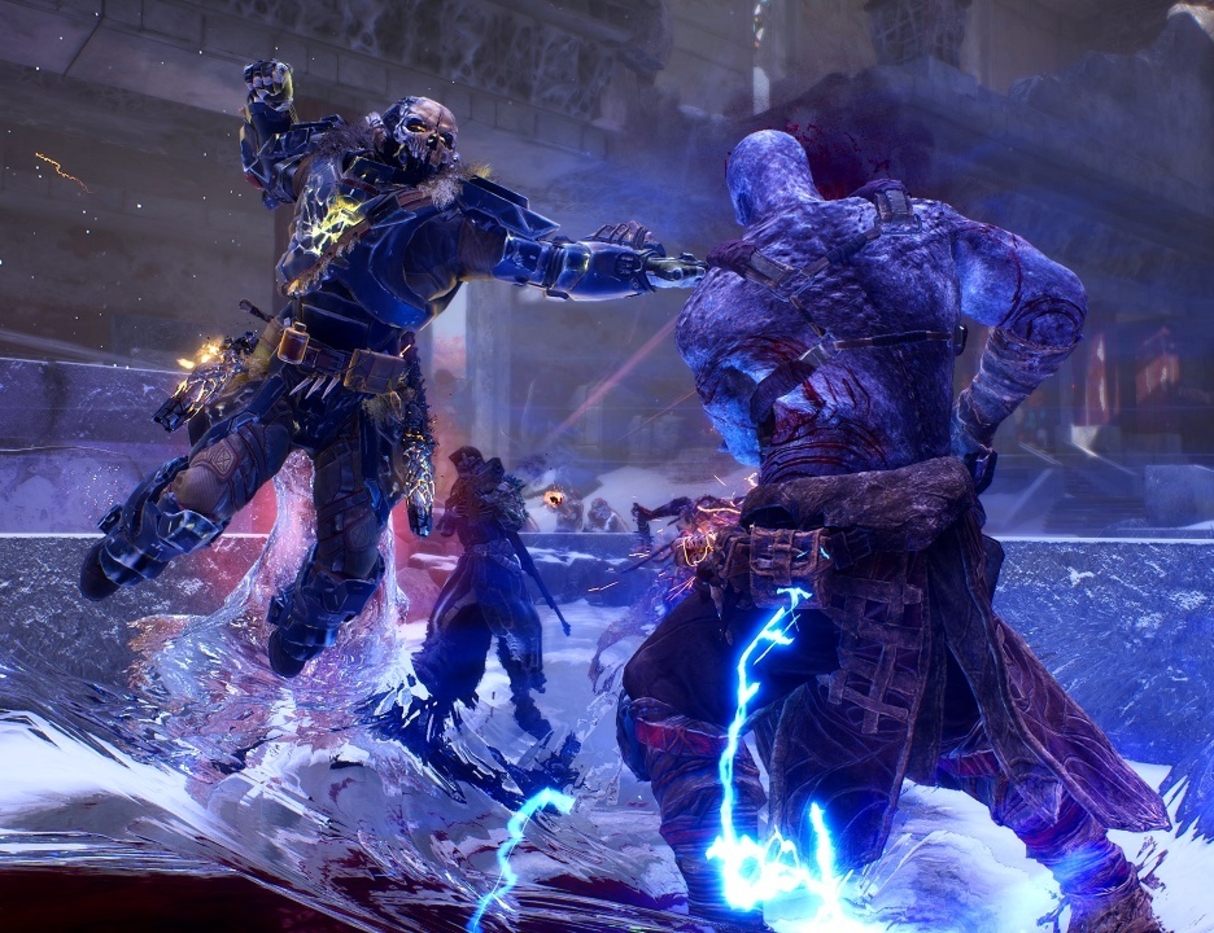Every time I return to Outriders, I’m reminded of how intense and fast-paced its core gameplay is. You play a superpowered killing machine who can create small-scale earthquakes, set enemies on fire, or teleport behind troops hiding in cover and tear them apart with your mind. Worldslayer, the game’s first major story expansion, mostly just offers more opportunities to use ridiculous powers and guns to blast more enemies. Though it adds more story, the really meaningful changes are of a smaller scale, adding more loot to chase and endgame content that improves the game overall. It’s not the most thrilling of expansions, but it does leave Outriders in a better place, with more to do and more reasons to tectonically shift enemies into oblivion over the long term.
Those endgame improvements were some that Outriders needed. Where the game stumbled to some degree at its release was with extensive loot mechanics in what is otherwise an RPG shooter. Outriders encourages you to replay the game on tougher difficulties with a long tail of chasing down top-tier weapons and armor. But once the story is done, it’s tough to stay interested. Though deep adjustable difficulty tiers meant you could challenge yourself and reap better rewards, the most lucrative place to play was in its repeatable endgame activity, Expeditions, which quickly started to feel a bit thin.
Developer People Can Fly has been making adjustments to the game since its launch in order to give fans more to do once the story is over, with those improvements culminating in Worldslayer. The expansion not only brings a few hours of additional story, it also adds significantly to the endgame, with new difficulty tiers, new skill trees to enhance your character, and new gear to earn. In other words, Worldslayer addresses Outriders’ initial shortcomings with a bunch of new things to hunt down.
Worldslayer picks up the story not long after the end of Outriders, and nothing much has changed from the base game. The Anomaly, a storm that murders most people and turns anyone who survives into a superpowered killing machine, is still a major threat, and war between human factions still rages with no end in sight. In fact, it’s getting worse, with the Anomaly storms growing more brutal across Enoch. Soon, it seems, there will be nowhere to hide, and humanity will cease to exist.
As in the base game, the player Outrider and their team–that’s you and your buds–head out to try to find information about why the storms are getting worse and what might be done about them. That requires traveling behind enemy lines to meet an enemy scientist. Things don’t go very well, however, because, as usual, there’s a big scary boss standing between humanity and its survival. That boss is Ereshkigal, the superpowered commander of the enemy faction. She’s all for the Anomaly sweeping across Enoch and killing just about everybody; as an Altered, Ereshkigal believes herself to be a god among mortals and wants the Anomaly to murder everyone who isn’t part of this next stage of evolution.
Worldslayer’s story lasts around six hours, and for the most part, it ties off the main plot threads that were hanging after the Outriders campaign as you figure out what to do about the Anomaly and deal with Ereshkigal’s interference. It’s a decently fulfilling wrap-up, if a little by the numbers, and without a lot of real weight. Worldslayer touches on a few of Outriders’ more interesting themes, like the idea of becoming so powerful that you lose your humanity, but doesn’t spend enough time to do more than gesture in their direction. The plot feels like its job is to provide you with new places to shoot baddies, and that’s about all the story amounts to in the end, despite some thoughtful additions to the game’s overall lore.

While the story campaign of Worldslayer adds more to do, with a few new enemy types that change up fights, the real upshot of the expansion is the way it reworks Outriders to make the game worth revisiting with more challenge. The base game introduced the “World Tier” system, which had players advancing up tiers almost like leveling up their character. As you became stronger, you’d earn points to level up your World Tier until you could unlock the next in line. Moving up to the next tier would give you better rewards, but it would also increase the difficulty of everything in the game. Alternatively, if a fight was getting frustrating, you could turn down the World Tier on the fly to make things a little easier. Worldslayer takes that system even further with new “Apocalypse” tiers, replacing World Tiers with 40 total tiers to progress through as you play (or replay) the game.
Apocalypse tiers work throughout Worldslayer as well as the base game, giving Outriders die-hards yet more reasons to replay content they’ve already worked through. The payoff for that heightened difficulty is new Apocalypse gear, which is even better than the guns and armor you could get in the base game. Items you earn in the original Outriders include two slots for modifications, some of which you can reassign using the game’s crafting system. Mods are what make gear in Outriders so ridiculous, because they generally do a lot of cool, weird things–increasing the power of a certain Altered attack, say, or automatically adding weird status effects or powerful blows to your bullets (like the gun that drops meteors on people, one of the best ideas to ever grace a shooter). Apocalypse gear gets three mod slots, adding even more chaotic nonsense to the mix and giving a pretty compelling reason to fight through and upgrade your stuff.
To handle the new difficulty, Worldslayer gives you ways to boost your character with two new systems, although their efficacy is a bit mixed. The main new avenue is with the PAX points system, which is just a pair of new skill trees for your character. Those new skill trees let you further specialize your Altered fighter with one of two new focuses: essentially, one that focuses on gunplay and the other on Anomaly powers. While there are a bunch of possible upgrades you can choose, you only get five PAX points, so there’s a bit of strategizing and customization in picking which skills are most meaningful to your character build. As with Outriders’ main skill tree system, however, you can respec whenever you want for free, so it’s easy to play around with different builds.
In addition to the PAX system is the more generous but less interesting Ascension system. This one awards points more frequently, which you can drop into one of 20 different areas. While you get a lot of these points and upgrades, they feel relatively minor in the moment, doing things like increasing your overall health by 1% or reducing your ability cooldowns by 0.3%. You can earn 200 points for the Ascension system, so these minor upgrades stack up–but it’s definitely more of a long-haul improvement than something that feels meaningful every time.

All of these systems culminate in The Trial of Tarya Gratar, a new endgame addition to Outriders to go along with Expeditions. Tarya Gratar is essentially a big dungeon players can pick their way through, filled with major engagements and a few tough bosses. The endgame area can be very difficult, depending on your Apocalypse tiers and choices, and like Expeditions, it’s best enjoyed in cooperative play as a team of three. The reward for fighting through each of its engagements, however, is a big pile of loot, with boss enemies dispensing gear like pinatas and each encounter ending with a treasure chest that absolutely dumps guns and armor on you.
Tarya Gratar is People Can Fly’s answer to issues with its endgame. There’s a primary path through the dungeon, with a few choices you can make as to which encounters you want to face along the way, as well as side areas called Troves that put you through a difficult multi-stage battle and give out even more rewards. The Troves are worth the challenge because they have a higher chance to give out top-tier Legendary armor, and each Trove is tuned to give out a specific type–you can get Legendary boots from one Trove, or Legendary helmets from another. The idea is that you can farm Tarya Gratar over and over again for drops of these particular types to fill holes in your collection.
In addition to all the sweet loot, Tarya Gratar offers a different kind of challenge than the rest of Outriders, thanks to new enemies and bosses that don’t appear anywhere else in the game. These fights require you to use different strategies, particularly when facing invisible Shadow Beasts and the Beast Masters who command them–the camouflaged monsters can momentarily rob you of your ability to use your superpowers, putting you at a significant disadvantage. Tarya Gratar also includes three big boss fights that come with their own mechanics, like capturing and holding a specific location in order to make the boss vulnerable, or destroying minion enemies before they can reach the boss and heal it. These fights are great changes of pace in a game that’s largely about running around, blasting everyone you can as fast as you can.
Tarya Gratar, along with the new loot to chase, new difficulty tiers to earn, and new character upgrades to farm, provide a more stable, healthier endgame to Outriders. And as a whole, Worldslayer improves the game in a significant way–all its additions help make Outriders worth returning to. They’re great for fans of the base game, and anyone who was intrigued by the game but missed it will find it in a better state than they would have a year ago at its launch.

It is, however, still Outriders. Worldslayer improves a strong shooter that already had some cool and weird ideas, enhancing its challenge and bringing a lot of small improvements that make it more enjoyable to play overall. But the expansion doesn’t add any especially new ideas, it just cleans up and adds to what’s already there. These are a series of incremental improvements and additions that make a weird, chaotic shooter worth revisiting a year after its release–just don’t expect anything world-shaking.










